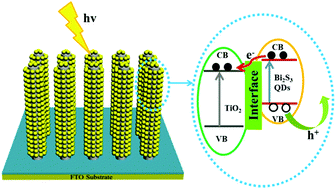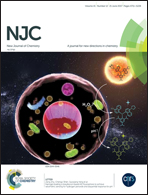Controllable coverage of Bi2S3 quantum dots on one-dimensional TiO2 nanorod arrays by pulsed laser deposition technique for high photoelectrochemical properties†
Abstract
In this work, the pulsed laser deposition (PLD) technique is applied for direct physical deposition of narrow bandgap semiconductor Bi2S3 quantum dots (QDs) on one-dimensional TiO2 nanorod arrays to fabricate quantum dots sensitized solar cells (QDSSCs). Without regard for any protective packaging or surface treatment process for binding QDs, the QDSSCs exhibit excellent stability and high energy conversion efficiency in ambient air. Through varying the laser ablation pulses, the controlled coverage of QDs on nanorods is realized and an optimal energy conversion efficiency of 3.06% is obtained under one sun illumination (AM 1.5, 100 mW cm−2). The enhanced absorption in an extended wavelength range, quick interfacial charge transfer and few recombination chances for electrons with holes are believed to contribute to the improved performance of Bi2S3 QD-sensitized solar cells. Moreover, a sputtered plasma at high velocity can collide intensely with the surface of TiO2, which enables direct atomic contact and endows the QDSSCs with high stability. These promising results provide a potential option of using the PLD technique for the fabrication of QD-based solar cells or other thin film photo-absorption materials.



 Please wait while we load your content...
Please wait while we load your content...